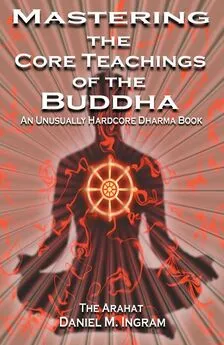Daniel Ingram - Mastering the Core Teachings of Buddha - An Unusually Hardcore Dharma Book
- Название:Mastering the Core Teachings of Buddha - An Unusually Hardcore Dharma Book
- Автор:
- Жанр:
- Издательство:Aeon Books
- Год:2009
- ISBN:9781904658405
- Рейтинг:
- Избранное:Добавить в избранное
-
Отзывы:
-
Ваша оценка:
Daniel Ingram - Mastering the Core Teachings of Buddha - An Unusually Hardcore Dharma Book краткое содержание
Mastering the Core Teachings of Buddha - An Unusually Hardcore Dharma Book - читать онлайн бесплатно полную версию (весь текст целиком)
Интервал:
Закладка:
The Radiance Models.....................................................................................303
The Karma Models........................................................................................306
The Perpetual Bliss Models...........................................................................307
The Three Kayas............................................................................................308
The Immortality models.................................................................................314
The Transcendence Models...........................................................................315
The Extinction Models...................................................................................316
The Love Models...........................................................................................317
The Unity Models...........................................................................................318
The Social Models..........................................................................................318
The Three Yanas............................................................................................320
Ditching our “Stuff” vs. Ditching the Split......................................................322
The “Nothing to Do” and “You are Already There” Schools.......................324
Final Points.....................................................................................................328
31. So What’s “Full Enlightenment”? *.....................................329
32. Integration*............................................................................333
33. It is Possible! .........................................................................337
34. More on the “Mushroom Factor”*.......................................339
35. So Who The Heck Is Daniel M. Ingram?...........................346
36. Conclusion And Best Wishes...............................................352
Appendix: The Cessation of Perception and Feeling (Nirodha
Samapatti)....................................................................................353
Index...........................................................................................357
iii
Foreword and Warning
FOREWORD AND WARNING
When I was about 15 years old I accidentally ran into some of the classic early meditation experiences described in the ancient texts and my reluctant spiritual quest began. I did not realize what had happened, nor did I realize that I had crossed something like a point of no return, something I would later call the Arising and Passing Away. I knew that I had had a very strange dream with bright lights, that my entire body and world had seemed to explode like fireworks, and that afterwards I somehow had to find something, but I had no idea what that was. I philosophized frantically for years until I finally began to realize that no amount of thinking was going to solve my deeper spiritual issues and complete the cycle of practice that had already started.
I had a very good friend that was in the band that employed me as a sound tech and roadie. He was in a similar place, caught like me in something we would later call the Dark Night and other names. He also realized that logic and cognitive restructuring were not going to help us in the end. We looked carefully at what other philosophers had done when they came to the same point, and noted that some of our favorites had turned to mystical practices. We reasoned that some sort of non-dual wisdom that came from direct experience was the only way to go, but acquiring that sort of wisdom seemed a daunting task if not impossible.
He was a bit farther along than I was in his spiritual crisis, and finally he had no choice but to give it a try. He quit the music business, moved back to California, and lived in a run down old mobile home, driving pizza to save money so that he could go off on a spiritual quest. He finally did some intensive meditation retreats and then eventually took off to Asia for a year of intensive practice under the guidance of meditation masters in the Burmese Theravada Buddhist tradition.
When he came back, the benefits of his practice were obvious, and a few years later I began to try to follow a similar path.
In 1994, I began going on intensive meditation retreats and doing a lot of daily practice. I also ran into some very odd and interesting experiences, and began to look around for more guidance on how to proceed and keep things in perspective. Good teachers were few and far iv
Foreword and Warning
away, their time limited and often expensive to obtain, and their answers to my questions were often guarded and cryptic. Even my old music friend was keeping most of what he knew to himself, and issues around disclosure of meditation theory and personal practice details nearly cost us our friendship.
Frustrated, I turned to books, reading extensively, poring over texts both modern and ancient looking for conceptual frameworks that might help me navigate skillfully in territory that was completely outside my previous experience. Despite having access to an astounding number of great and detailed dharma books, I found that they left out lots of details that turned out to be very important. I learned the hard way that using conceptual frameworks that were too idealistic or that were not fully explained could be as bad as using none at all. Further, I found that much of the theory about progress contained ideals and myths that simply did not hold up to reality testing, as much as I wanted them to.
I also came to the profound realization that they have actually worked all of this stuff out. Those darn Buddhists have come up with very simple techniques that lead directly to remarkable results if you follow instructions and get the dose high enough. While some people don’t like this sort of cookbook approach to meditation, I am so grateful for their recipes that words fail to express my profound gratitude for the successes they have afforded me.
Their simple and ancient practices revealed more and more of what I sought. I found my experiences filling in the gaps in the texts and teachings, debunking the myths that pervade the standard Buddhist dogma and revealing the secrets meditation teachers routinely keep to themselves. Finally, I came to a place where I felt comfortable writing the book that I had been looking for, the book you now hold in your hands.
This book is for those who really want to master the core teachings of the Buddha and who are willing to put in the time and effort required. It is also for those who are tired of having to decipher the code of modern and ancient dharma books, as it is designed to be honest, explicit, straightforward and rigorously technical. Like many of the commentaries on the Pali Canon, it is organized along the lines of v
Foreword and Warning
the three basic trainings that the Buddha taught: morality, concentration and wisdom.
Throughout this book I have tried to be as utilitarian and pragmatic as possible, and the emphasis is always on how to actually “get it” at the level that makes some difference. All sections also assume to some degree that you have a practice of some sort, hang out in some sort of spiritual scene, and know a bit of the standard dharma lingo. All sections also assume that you are willing to do the work.
I have tried to include enough information to make this book capable of standing on its own as a manual of meditation and for walking the spiritual path. However, I have also tried to focus on those areas that I consider to be my core competencies and also those areas of the spiritual path that I do not feel have been adequately covered in the works that have come before this one. This book shines in areas of technique and the fine points of very high-level practice. However, the spiritual life is vast beyond measure and cannot possibly be adequately covered in a single book. Thus, I will often refer you to other excellent sources for more details on those topics that I feel have already been covered quite well by other authors. I strongly suggest checking out at least some if not all of these other sources.
Like my own practice, this book is heavily influenced by the teachings of the late, great Mahasi Sayadaw, a Burmese meditation master and scholar in the Theravada Buddhist tradition, and by those in his lineage and outside it. There are numerous references to other excellent traditions as well, some Buddhist and some not. It is my sincere wish that all diligent students of meditation find something in this book that is of practical value to them.
I have included a few of my own experiences and labeled them as such. This is done to try to add some sense of the reality of what is possible, both in terms of successes and failures. They should add a human dimension to the theory. However, if you find that these stories get in the way, or if they seem to have too much of the quality of “let me tell you about my personal spiritual quest,” please do us both a favor and skip over them without a second thought.
I have also written this book in what is clearly my own voice. Those who have read this work who know me tell me that they can almost hear vi
Foreword and Warning
me saying it. I have also left in a lot of my neurotic stuff and made it as obvious as I can. I will assert that anyone who writes puts their stuff in there even if they try to hide it, so at least you should be able to see it clearly rather than it being hidden and covert. If you want a book that is just the straight dogma and theory without this sort of voice, there are lots to choose from and I will mention a number along the way.
I have also included a modicum of social commentary, some of which has a definite bite to it. Some of you may not find it helpful, or even find it quite distasteful and offensive. Some of you will quickly dismiss it as harsh or wrong speech. I am torn between the feeling that there really are some important points in those sections and the understanding that not everyone will be able to make good use of information and opinions presented in such strong terms. Thus, I ask you to please skip over those chapters and get to the friendlier or more technical sections beyond them if you don’t find them helpful. To facilitate doing so, I have included a star (asterisk) in the titles of those chapters that contain potentially inflammatory material so that they may be treated appropriately.
While I feel that the points made in those chapters are important and potentially quite valid and useful, they are not absolutely necessary for understanding the chapters that follow them. The world is brimming with very nice and friendly dharma books. There are hundreds available on the shelves of any mega-bookstore. However, I believe that there is room for a book that sometimes conveys its message in a very different voice, though I respectfully give you the option to choose how much of that voice you want to hear. It is the unrestrained voice of one from a generation whose radicals wore spikes and combat boots rather than beads and sandals, listened to the Sex Pistols rather than the Moody Blues, wouldn’t know a beat poet or early ‘60s dharma bum from a hole in the ground, and thought the hippies were pretty friggin’ naïve, not that we don't owe them a lot. It is also the unrestrained voice of one whose practice has been dedicated to complete and unexcelled mastery of the traditional and hardcore stages of the path rather than some sort of vapid New Age fluff or pop psychological head-trip. If that ain’t you, consider reading something else.
Читать дальшеИнтервал:
Закладка:





![Дженнифер Гюнтер - The vagina book. Главная книга для тех, у кого есть этот орган [litres]](/books/1061538/dzhennifer-gyunter-the-vagina-book-glavnaya-kniga-dl.webp)




